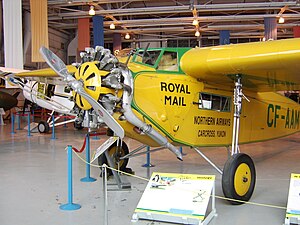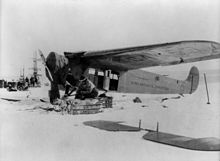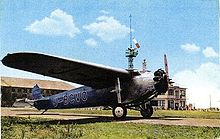Fokker Super Universal
| Fokker Super Universal | |
|---|---|
 Super Universal in the Royal Aviation Museum of Western Canada |
|
| Type: | Airliner , transport aircraft |
| Design country: | |
| Manufacturer: | |
| First flight: |
March 1928 |
| Number of pieces: |
> 200 |
The Fokker Super Universal (Atlantic-Fokker Model 8) was a single-engine cargo and airliner manufactured by the US manufacturer Atlantic Aircraft Corporation , later the Fokker Aircraft Corporation of America, a subsidiary of Fokker. It was the successor to the Fokker (Standard) Universal , but had significantly larger dimensions than its predecessor. Externally, it can be distinguished from the Standard Universal mainly by the lack of struts on the wing.
After General Motors had acquired a 41 percent stake in the Fokker Aircraft Corporation of America in May 1929 and the company was renamed General Aviation Corporation (GAC) a year later , the GAC fulfilled Fokker's production obligations.
history
The model was initially called Universal Special, but was soon changed to Super Universal. The hull length and the wingspan have been increased compared to the Standard Universal. The new machine also received a more powerful engine with a 420 hp Pratt & Whitney Wasp , but other engines could also be installed relatively easily. Construction was moved to a new factory in Glendale, West Virginia, where 80 machines were manufactured. The Super Universal was thus the most built aircraft of the Fokker Aircraft Corporation . 14 aircraft were exported to Canada, where another 15 examples were built under license by Canadian Vickers. About 13 machines could also be exported to Japan. Nakajima then produced a large number of them under license. Around 50 are said to have been produced as civilian Aikoku 40s , while the Japanese Army ordered another 20 as Ki.6 Type 95-2.
The Japanese Navy also received 50 Super Universal, with the wheeled aircraft version designated as C2N1 and the float version as C2N2.
The Super Universal's service life was relatively short, with only a few aircraft flying until the early 1940s. Some aircraft built by Nakajima were used in World War II, and Japan gave some more to the air forces of the puppet state of Manchukuo .
The US Navy tested a Super Universal ( Bureau Number A8012) under the designation XJA-1 , but was not satisfied with the results and returned the machine to the manufacturer. Fokker later sold them to Canada. The US Navy later used the designation JA-1 again for four Noorduyn Norseman .
In civilian use, the Super Universal was particularly popular with bush pilots in Alaska and Canada. Airlines use them profitably on feeder routes. Individual companies also used them as business aircraft. On average, an airplane cost $ 17,500 in 1928.
Admiral Richard Evelyn Byrd also used a Super Universal on his first Antarctic expedition in 1928/29, which was called "Virginia".
construction
The Super Universal was a cantilevered shoulder wing . In addition to the lack of wing struts compared to the Standard Universal, which was replaced by the internal bracing typical of the Fokker, the Super Universal also had an improved and simplified, but still non-retractable landing gear . An exception was the prototype (serial number 800), which is said to have flown as early as 1927 and still had the double struts of the wing and a landing gear similar to that of the original Universal. The take-off weight was also slightly lower than the later versions at 2050 kg.
The one-piece, self-supporting wing was braced internally in the classic Fokker timber construction and planked with plywood. The thick profile corresponded to the type that Fokker also used in other commercial aircraft at the time. The fuselage had a load-bearing structure consisting of a welded frame made of stainless steel tubes. The fuselage was brought into a rounded shape with molded parts and covered with fabric. On the left was the access door to the passenger compartment, which could accommodate six people. The seats could easily be removed, which enabled a cargo load of 570 kg.
The standard equipment included metal propellers, navigation lights, a tail wheel and a hand crank starter. The wheel chassis could be exchanged for ski runners or a floating mechanism.
Technical specifications
Data from Joseph P. Juptner (1962), p. 138
| Parameter | Wheel chassis | Hamilton metal float | 450 hp version |
|---|---|---|---|
| crew | 2 | ||
| Passengers | 6th | ||
| length | 1.16 m | ||
| span | 18.50 m | ||
| height | 2.67 m | ||
| Wing area | 34.37 m² | ||
| Empty mass | 1360 kg | 1610 kg | 1475 kg |
| Takeoff mass | 2340 kg | 2340 kg | 2520 kg |
| Top speed | 221 km / h | 208 km / h | 221 km / h |
| Cruising speed | 189 km / h | 176 km / h | 189 km / h |
| Landing speed | 90 km / h | 88 km / h | 94 km / h |
| Summit height | 5490 m | 4880 m | 5340 m |
| drive | 1 × radial engine Pratt & Whitney Wasp with 420 PS (309 kW) |
1 × Pratt & Whitney Wasp with 450 PS (331 kW) |
|
Preserved copies
The only surviving machine was exhibited in the Western Canada Aviation Museum in 2019 . This Super Universal (serial number 827, aircraft registration number CF-AAM) was built in Teterboro in early 1929 for Consolidated Mining & Smelting Co. (COMINCO), which sold it to Northern Airways in 1934. The company chartered the machine to National Geographic Magazine , among others , which carried out an expedition to the Saint-Elias mountain range and published photos of the mountains, up to 5900 m high, for the first time in June 1936. On December 2, 1937, the aircraft had a take-off accident on the snow-covered airfield of Dawson (Yukon Territory of Canada). There were no injuries, but the machine was so badly damaged that it was not rebuilt. In its almost nine years of service, it had accumulated a total of 3252 flight hours. During the restoration, which lasted from 1981 to 1998, the remains of two other Super Universal (CF-AJC, CF-ATJ) were also used. Instead of the original Wasp engine, a more serviceable Pratt & Whitney R-1340 radial engine was used . On July 24, 1998, the rebuilt CF-AAM made its first 15 minute flight.
Until 2005, the aircraft took part in numerous flight days in North America before it found its final place as an exhibit in the museum.
Byrd's Super Universal was rediscovered in 1987 during an expedition to Antarctica.
literature
- ER Johnson: United States Naval Aviation 1919-1941 , McFarland and Co., 2011, ISBN 978-0-7864-6269-8 , pp. 190 f.
- Bart van der Klaauw: Fokker's American Heydays . In: AIR Enthusiast No.68, March – April 1997, pp. 2–15
- John M. Andrade: US Military Aircraft Designations and Serials since 1909 , Midland Counties Publ., 1979, ISBN 0-904597-22-9 , p. 197
- Joseph P. Juptner: US Civil Aircraft Series. Volume 1, Aero Publishers, 1962, no ISBN, pp. 137-138
Web links
Individual evidence
- ^ Andrade, 1979, p. 198
- ^ First Byrd Antarctic Expedition , accessed January 2, 2020
- ↑ Film recordings of Richard Byrd's Super Universal "Virginia" , accessed on December 21, 2019
- ↑ Joseph P. Juptner: US Civil Aircraft Series Volume 9 , Aero Publishers, 1981, reprinted 1994, p. 106
- ↑ Xavier Meal: Return of the Super Universal . In: Airplane Monthly June 2001, pp. 57-64
- ↑ CF-AAM on the Western Canada Museum website , accessed January 5, 2020



